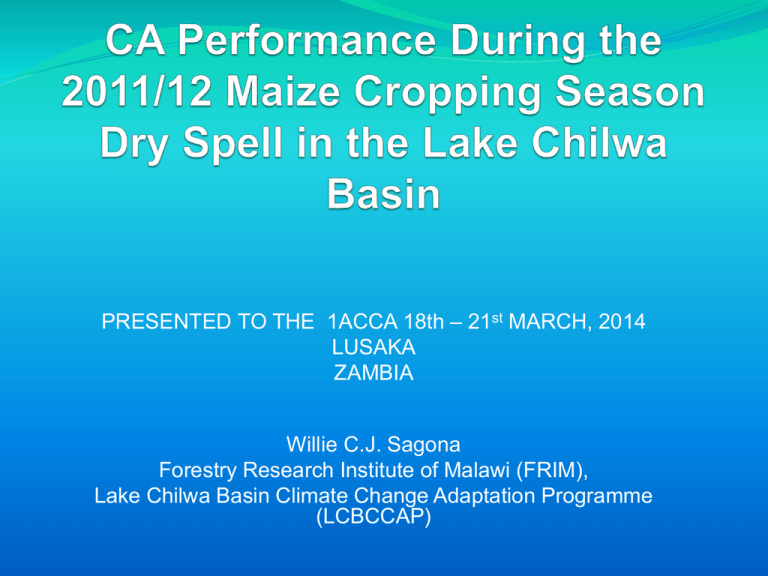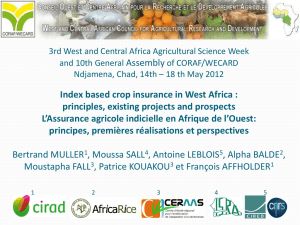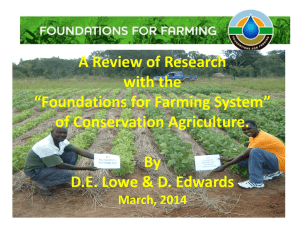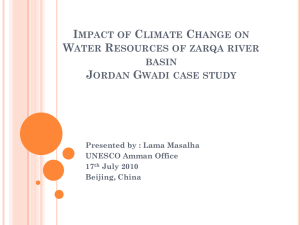CA Performance During the 2011/12 Maize Cropping Season Dry
advertisement

PRESENTED TO THE 1ACCA 18th – 21st MARCH, 2014 LUSAKA ZAMBIA Willie C.J. Sagona Forestry Research Institute of Malawi (FRIM), Lake Chilwa Basin Climate Change Adaptation Programme (LCBCCAP) Presentation Outline Introduction Study Methodology Data processing Results and discussion Conclusion Introduction CA for agriculture development and food security in Malawi. Climate variability and unreliable weather patterns has made production unpredictable (Tadross et al., 2005). Increases in mean dry spell length and reductions in rain day frequency have been experienced in Lake Chilwa Basin (LCB) These observations are also consistent with other spatial trends for late onset and increased length of the dry season (Hewitson and Crane, 2006). In addition, there have been documented increases in temperature over these same regions (Tadross, et al., 2005). This has led to changes in land-use and multi-decadal climate factors. CA practice in Mw has the potential for an increased soil, water and nutrient buffer capacity for a sustained stable productivity. CA offers an opportunity to mitigate the effects of climate change and variability. Materials and Methods SITE: Methodology: Total farmers interviewed – 106 85 CA farmers were randomly sampled from 267 CA farmers 21 conventional farmers were randomly sampled from EPAs as a control group. An interview guide was used to collect data. Pretesting of the interview guide Field observation Rainfall data Respondents had planted their maize in the first wk of December Data processing The data was entered and analyzed using SPSS version 16.0. Descriptive statistics were used to compute or calculate some of the common measures of numerical scale of measurement: Averages Skewness and kurtosis Standard deviation and ranges. Microsoft Excel was also used to summarize and analyze rainfall data. Results and discussion HOUSEHOLD AND LAND HOLDING SIZE The hhs involved in the study have on avge 5.7 persons Among the sampled hhs, 54.7% reported more than six hh members. 2004/05 Income and Household Survey - a mean hh size of 4.5, with 30.3% reporting 6 or more hh members. HOUSEHOLD AND LAND HOLDING SIZE…Cont’d The study reported a mean land holding size of 0.2 ha. Mw has one of the highest popn densities in SSA with 0.23 ha of arable land per capita (Concern Universal , 2011) The small land holding predisposes small holder farmers to vulnerability because their land holdings are very unproductive. CA performance during the dry spell 83.6% of the respondents noted that CA fields survived the water stress condition. 52% attributed this to CA farming technology while others cited soil type (16.1%) and time of planting (25.5%) as being the reason. Field observations - CA fields had survived the dry spell even though the impact of the dry spell could not be completely eliminated. CA performance…Cont’d It is rather early to attribute the findings to CA supremacy but the difference between CA and other fields were so fascinating to ignore especially in the face of the dry spell. These findings can only be confirmed through further studies that deliberately isolate input supply levels under different farming systems, soil type and time of planting. CA in the wake of dry spell 31.4% of respondents planted their maize in December using hybrid seed. Success of a chosen cultivar for planting the rain-fed maize crop is largely dependent on characteristics of the climate, and in particular rainfall, during the growing period (Tadross et al, 2005). Cumulative rainfall data (≈700mm) recorded from October to early February across the basin EPAs show that the year did not receive good rains when it was expected. The basin did not receive minimum moisture of 25mm of cumulative rainfall in 10 consecutive days required to sow and grow maize. CA in the wake of dry spell The October and November rains were “false starts as they could not even fall in 4 consecutive days in these months and in any case did not accumulate to 45mm when they fell beyond one day” Raes, et al., 2004. Respondents (61.3%) indicated that it took at least two weeks before the next rains came after planting. Rainfall characteristics that may have particularly impacted on maize growth during this period are: (1) long dry spells during the germination and growth phases (limiting water availability), (2) high intensity rainfall during the germination (resulting in water logging) and ripening (resulting in rotting and fungal infections) phases (Tadross et al., 2005). CA is thus beneficial to these farmers with respect to these shocks because it has the potential to improve moisture storage in the soils. Maize production from the study area The study revealed a mean maize yield prospect of 550kg from 0.2 hectare, thus 2.9 t/ha. Studies from elsewhere have shown CA maize production of up to 4.5 t/ha compared to 1.5 t/ha. Farmers have attributed better yields in CA to a mulching effect of crop residue. The findings vindicate the existing evidence that CA improves soil nutrients, increases the soil’s ability to retain water (Kassam, et al., 2009) . CA therefore ensures that productivity can be sustained in the medium to long term. Conclusion Study affirmed the fact that CA performed well during the dry spell. CA is most effective when promoted alongside other ‘climate resilient’ agricultural practices CA has been significant during these hard times because it used the little moisture that was retained under mulch to survive the dry spell and gained vitality when normal rains resumed. However, it is no doubt that the dry spell generally had a negative impact on overall expected yield. CA studies required in the basin on effect of input levels and hydraulic conductivity of soils. THE END THANK YOU FOR YOUR ATTENTION!!











